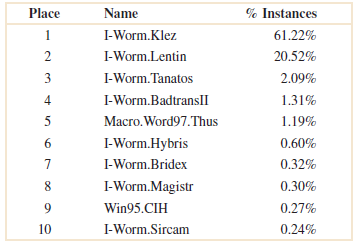Question: An article in Information Security Technical Report [Malicious SoftwarePast, Present and Future (2004, Vol. 9, pp. 618)] provided the following data on the top 10
The 10 most widespread malicious programs for 2002

Suppose that 20 malicious software instances are reported.
Assume that the malicious sources can be assumed to be independent.
(a) What is the probability that at least one instance is €œKlez?€
(b) What is the probability that three or more instances are €œKlez?€
(c) What are the mean and standard deviation of the number of €œKlez€ instances among the 20 reported?
% Instances Place Name 1 I-Worm.Klez 61.22% 2 I-Worm.Lentin 20.52% I-Worm. Tanatos 2.09% 4 I-Worm.BadtransII 1.31% Macro. Word97.Thus 5 1.19% I-Worm.Hybris 0.60% I-Worm.Bridex 0.32% 8. I-Worm.Magistr 0.30% Win95.CIH 0.27% 10 I-Worm.Sircam 0.24%
Step by Step Solution
3.46 Rating (166 Votes )
There are 3 Steps involved in it
a n 20 p 06122 PX1 1 PX... View full answer

Get step-by-step solutions from verified subject matter experts


